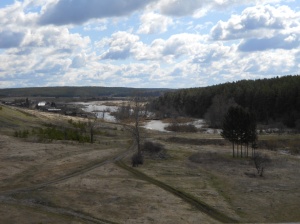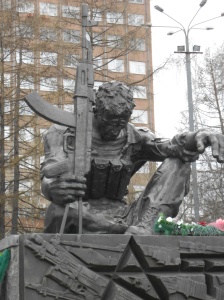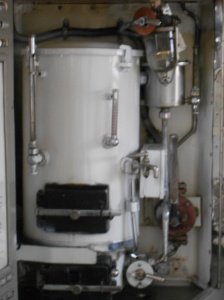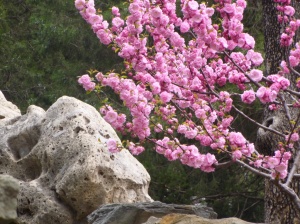AB says:
Our itinerary for today from our travel agents, Flower Travel, Melbourne, listed a few options from which we could choose. I can’t remember what they all were, I think one of them had to do with the assassination of the Romanovs, and a couple of others weren’t available to us because it was the wrong season. So we chose “Siberian Countryside and Historic Village”, which sounded interesting enough.
The day proved to be inspiring, to say the least. We were taken by Constantin, the owner of a local travel agency out to the village of Aramashevo, about 120 km north-east of Ekaterinburg. Along the way, we were treated to wonderful views of the countryside, and a wide-ranging and fascinating conversation with Constantin, covering topics from current politics to Australian indigenous issues, to his passion for the countryside and way of life, to what it’s like to run a small business in Russia, oh, and 1970s pop group Smokey. Apparently they’re huge in Russia!
We arrived in Aramashevo and were honoured to be introduced to Vera Reymova. This amazing woman is a retired school teacher and former director of the museum in her village. We met Vera at the village church, a beautiful building which is still being renovated after it was damaged during Soviet times and had its bell hurled down a nearby cliff into the river below. Vera and her husband were the initiators and main organisers of this amazing work, which they began in 2005. They and the church have been the subject of a Russian television program, and they have received financial support from the local government and generous donors. Even more importantly, important icons which were hidden, at great risk, by villagers during the times of the persecution of the church in Russia, have slowly come to light and been returned to the church, which has been a source of a great deal of joy. The Orthodox Church celebrates Easter on this coming Sunday, and it was indeed inspiring to hear this story of resurrection during Holy Week.
As if that wasn’t enough, Vera and her husband have also been pivotal in the renovation of two houses, and their development as a place for education about village life in the region in earlier times. We were shown the ‘summer house’ and the ‘winter house’, and told the story of how both of them were partially submerged in mud, and how Vera and her husband, along with volunteers who helped them, undertook the work of restoring them to their former glory. Of particular significance were the paintings of the walls. Vera told us that not all families could afford to have their homes painted by the travelling painters who would call, offering their services. Sometimes, they could only afford to have the door painted. However, Vera remembered that her home had been decorated in this way, including the ceilings, and remembers waking up every morning to see the paintings of flowers on the ceiling, and the joy that would bring her. Vera told us the significance of the design, which reflected the philosophy of the circle of life and the importance of family.
Vera has been recognised for the work that she has done, and the museum created by the two houses has received a federal government award. She told us the story of how her usual religious newsletter was not delivered one week, and instead she received something else. On the back of it, there was a notice about applying for this particular award, and that there was only a week until the applications closed. Her granddaughter helped her with the application, and their project won the award, along with a grant to help complete the restoration of the houses. Without it, they would not have been able to employ the specialist painters who replicate the designs and styles of earlier times.
Vera served us afternoon tea in one of the houses, and showed us how they teach children who come to weave. Vera didn’t join us in the feast she had prepared for us, because she was fasting for Lent. She then dressed JB and I up in traditional costumes – 200 years old, she told us! – and we had our photos taken. I’m sure I look very authentic in my glasses! A special gift as we left was the blessing she gave us on our way. An amazing woman, whose passion for her church, her village, and a disappearing way of life has enriched the lives of many people. What an inspiration.
Many, many Russians have a ‘summer house’ that they escape to when the weather is warm. It is usually a short drive from the city, and they may move there for the whole summer, or just head there for weekends. It enables them to fully enjoy the brief period of time when the outdoors is actually hospitable, and many ‘dachnik’ have a garden which supplies them with fruit and vegetables, and the chance to connect with their ‘inner peasant’. In the village where we visited Vera, one third of the population is now dachniks.
And, finally, a half-way decent coffee! Actually, a very decent coffee, if a little on the cool side for me. We didn’t need much to eat after the feast in Aramashov, but stopped off at Traveler’s Coffee (thanks, Ellen, for sussing it out for me!) was much appreciated, even though I accidentally ordered an espresso first. Gotta watch exactly where you’re pointing on the menu!
JB says:
Constantine, our driver who picked us up at the train, picks us up at9.30 am for a ‘countryside Siberian experience.’ This could be anything!
It turns out that after a 1 hour drive north into the Urals, we meet a Russian woman who is the ‘lightning rod’ for initiating the rebuilding/resurrection of an old Russian Orthodox stone church from the 18th century that was partly destroyed by the Bolsheviks after 1917.This is a story of commitment, faith, perseverance, and cannot be heard without being affected by it. I am.
She has also been responsible for initiating a small museum in her village. This example has provided the impetus for many other similar museums in ohter villages in the region.We experience the food, the living quarters, and particularly revealing, some of the social milieu of the time.
Home at around 5 pm. Annette wants a coffee, I want tea. We go and do both.
After this, we venture into a multi-storey shopping centre that is like several in Melbourne. Half of the shops have names in English. A supermarket is attached. It is huge, open 24 hours a day, with, to our eyes, lots of quirks. For example, liquor is on the same site. Beer of varying types is available on tap, and will be supplied into your own bottle.
Home to bed.
PS. Ekaterinburg is attempting to b e host city for World Expo 2020. Good luck!


































